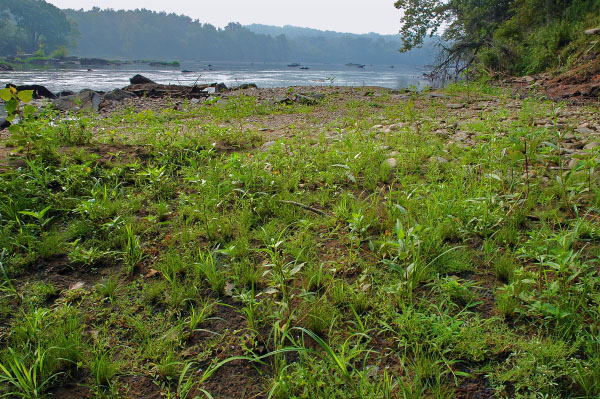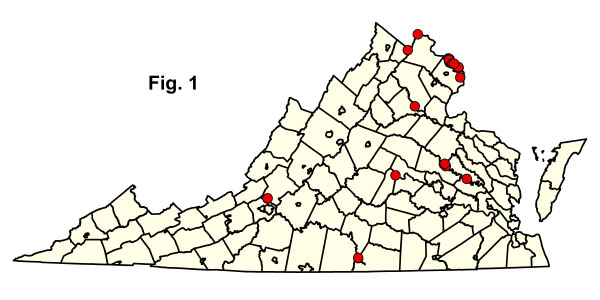

Virginia Department of Conservation and RecreationAn official website of the Commonwealth of Virginia Here's how you knowAn official websiteHere's how you know

Virginia Department of Conservation and RecreationAn official website of the Commonwealth of Virginia Here's how you knowAn official websiteHere's how you know
 Department of Conservation and Recreation
Department of Conservation and Recreation
 Table of Contents
Table of ContentsSand / Gravel / Mud Bars and Shores
The intermittently exposed shores and depositional bars of rivers and large streams support specialized herbaceous vegetation. Communities in this group are small, localized in distribution, and distinctive both environmentally and floristically. They are widely scattered throughout Virginia, but are most frequent and best developed along large rivers. The same vegetation may also be found, sometimes in very large stands, on seasonally exposed bottoms and shores of reservoirs in impounded rivers. Habitats are typically submerged during the winter and spring, but draw down during the summer and may be extensively exposed during the late summers and falls of dry years. Substrates consist of fine-textured to moderately coarse alluvium. The vegetation is variable but generally dominated by herbaceous species that are specially adapted to cycles of flooding and exposure. Seed banks or perennial rootstocks of these species are capable of maintaining their viability during long periods of submersion, quickly germinating or sprouting when favorable draw-down conditions occur. Flood-battered shrubs and tree saplings occur sparsely in these habitats.
Species of relatively wide distribution on sandy or gravelly draw-down shores include creeping dayflower (Commelina diffusa), red-root flatsedge (Cyperus erythrorhizos), creeping lovegrass (Eragrostis hypnoides), halberd-leaf rose-mallow (Hibiscus laevis), small-flower halfchaff sedge (Cyperus subsquarrosus), common water-willow (Justicia americana), low spikesedge (Cyperus hortensis), false pimpernels (Lindernia dubia var. dubia and var. anagallidea), seedboxes (Ludwigia spp.), spreading panic grass (Panicum dichotomiflorum var. dichotomiflorum), water paspalum (Paspalum fluitans), marsh yellow cress (Rorippa palustris ssp. palustris ), and toothcup (Rotala ramosior). Species characteristic of Piedmont and mountain draw-down shores include scarlet ammannia (Ammannia coccinea), nodding beggar-ticks (Bidens cernua), three-lobe beggar-ticks (Bidens comosa), spreading sandmat (Euphorbia humistrata), awned flatsedge (Cyperus squarrosus), dock-leaf smartweed (Persicaria lapathifolia), and Carolina leaf-flower (Phyllanthus caroliniensis ssp. caroliniensis). Species most typical of Coastal Plain draw-down shores include white-edge flatsedge (Cyperus flavicomus), coastal flatsedge (Cyperus polystachyos), shade mudflower (Micranthemum umbrosum), lax hornpod (Mitreola petiolata), American halfchaff sedge (Cyperus neotropicalis), Bosc's bluets (Oldenlandia boscii), warty panic grass (Kellochloa verrucosa), and coastal rose-pink (Sabatia calycina).
References: DeBerry and Perry (2005), Fleming (2007), Lea (2000), Ludwig (1996).
Click here for more photos of this ecological community group.
 © DCR-DNH, Gary P. Fleming.
© DCR-DNH, Gary P. Fleming.

 Download a spreadsheet of compositional summary statistics (Excel) for each of the community types listed below.
Download a spreadsheet of compositional summary statistics (Excel) for each of the community types listed below.

